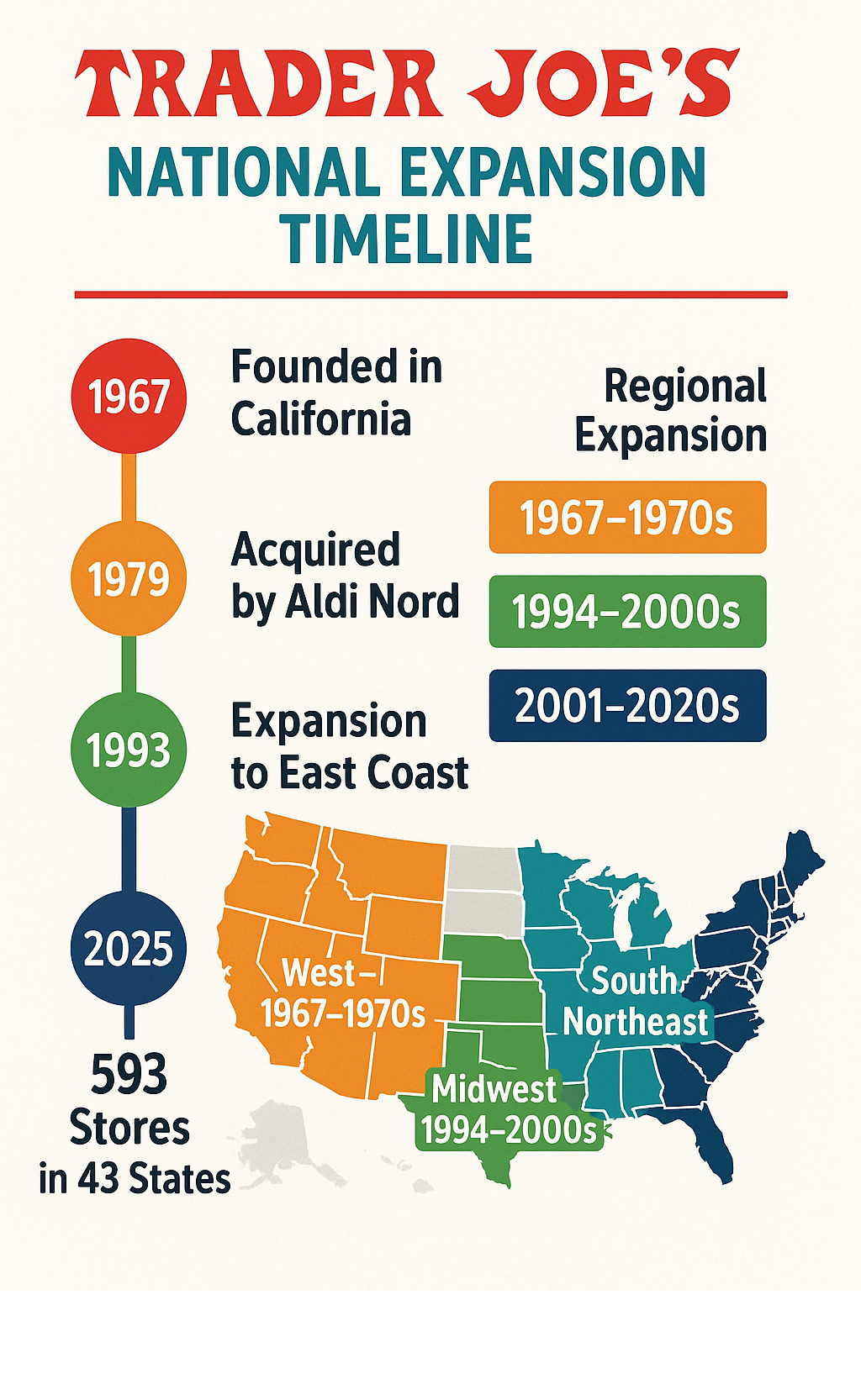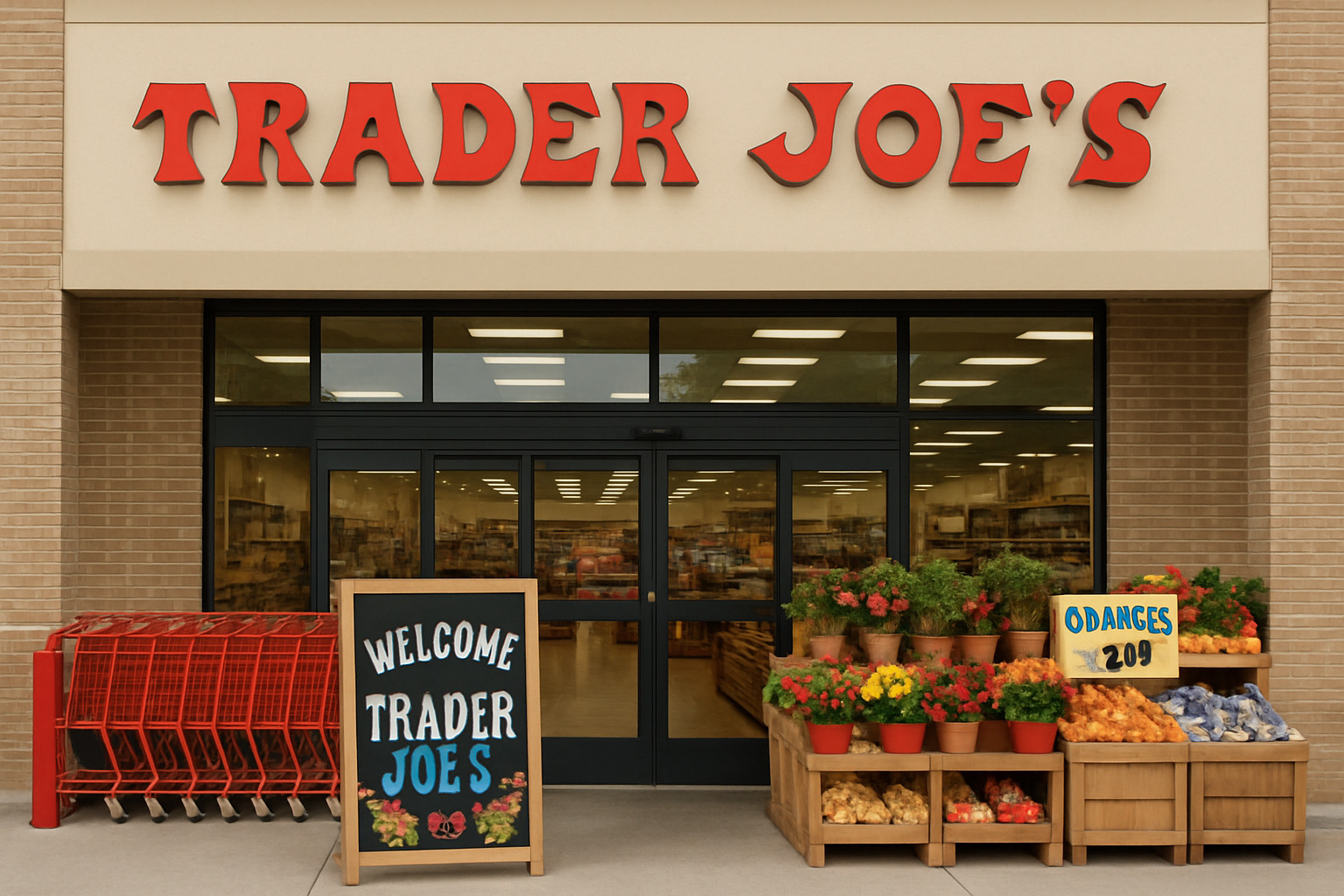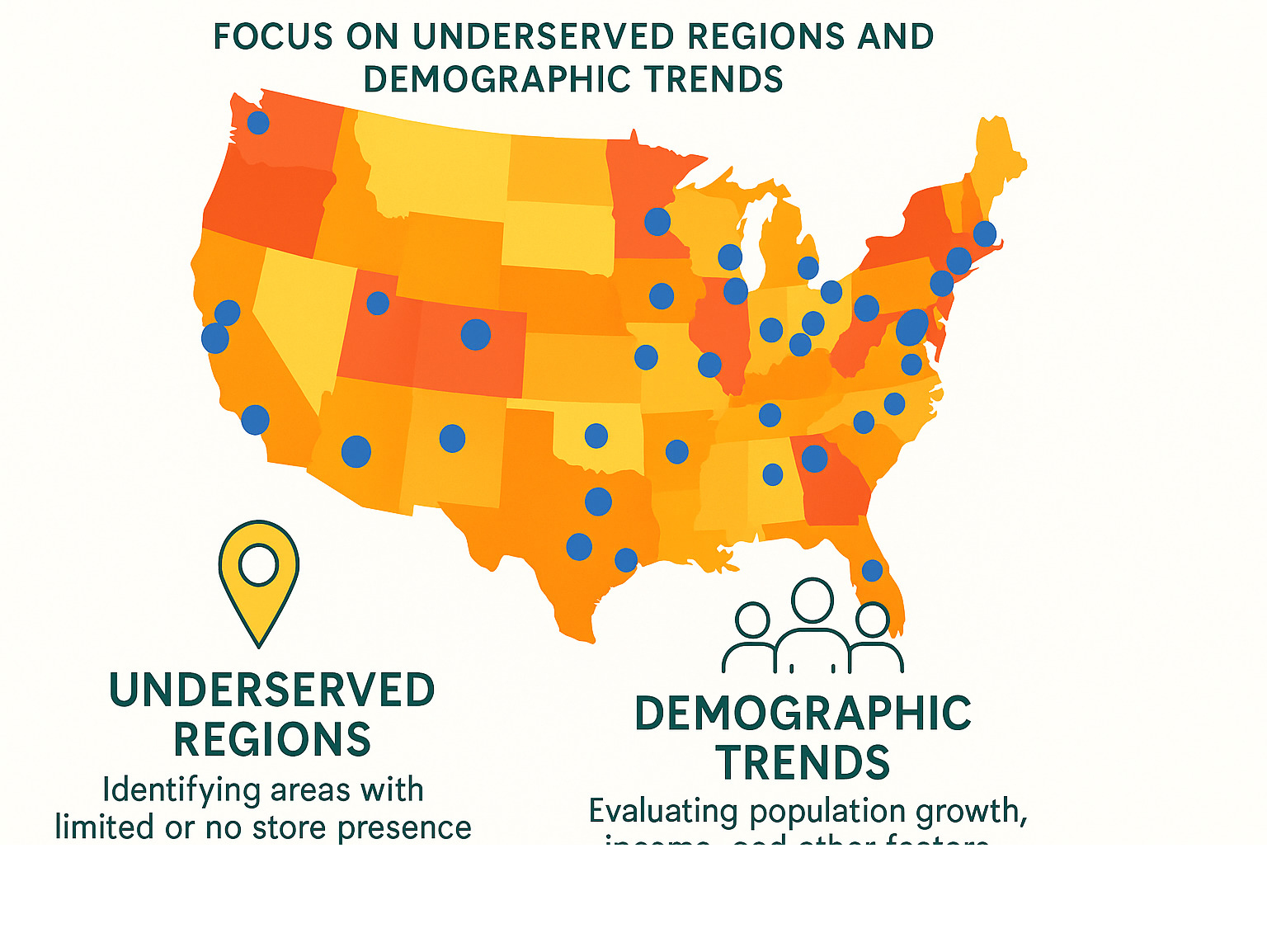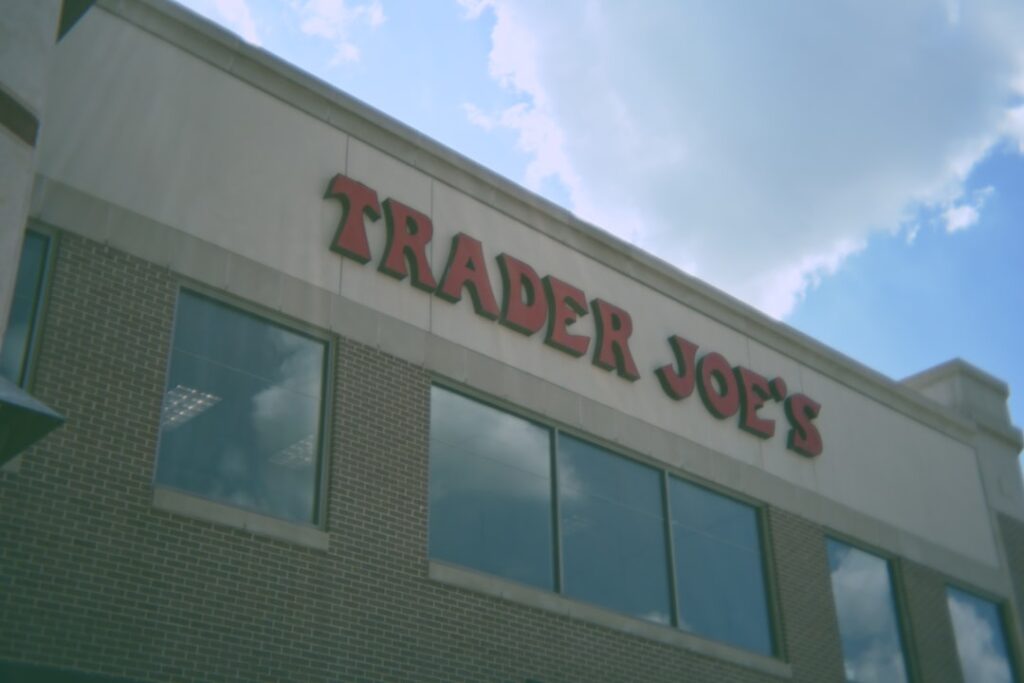Why Trader Joe’s Has Become America’s Most Beloved Grocery Chain
Trader Joe’s operates 593 stores across 43 states and the District of Columbia, serving millions of customers who can’t get enough of their unique products, everyday low prices, and friendly crew members. Here’s what makes this grocery chain special:
Quick Facts About Trader Joe’s:
- Founded: 1967 by Joe Coulombe
- Stores: 593 locations nationwide
- Revenue: $16.5 billion (2020)
- Employees: Over 50,000
- Private Label: 80% of their 4,000 products
- Sales Performance: Highest sales per square foot of any U.S. grocer ($1,750)
With thriving outposts in New York City—the hometown of The Dining Destination—Trader Joe’s shows how its neighborhood-focused model succeeds in dense urban environments as well as suburban communities.
What started as a single store in California has grown into a cult-favorite grocery chain that does things differently. While most supermarkets stock 50,000 items, Trader Joe’s keeps just 4,000 carefully curated products. They don’t offer sales, coupons, or loyalty programs – instead focusing on what they call the “Three Ps”: Products, Prices, and People.
Each store feels like a treasure hunt with its South Seas-themed decor, hand-drawn signs, and Hawaiian shirts. Kids search for hidden stuffed animals while parents find everything from trader joe’s store locations featuring Korean bibim-guksu to cult-favorite “Two Buck Chuck” wine.
The company’s success comes from their private-label strategy – about 80% of products carry the Trader Joe’s name or playful variations like “Trader José” for Mexican items. Every product goes through rigorous taste-testing panels before earning shelf space.
From their headquarters in Monrovia, California, Trader Joe’s has built a loyal following of customers who drive past other grocery stores just to shop there. California leads with 193 locations, but the chain continues expanding into new markets where median household incomes exceed $100,000.

Trader Joe’s Store Footprint Across the United States
When you look at Trader Joe’s store locations across America, one thing becomes crystal clear: this isn’t your typical grocery chain expansion story. With 593 stores spread across 43 states, they’ve created something truly remarkable – the highest sales per square foot of any grocer in the country at an impressive $1,750.
The heart of this empire still beats in California, where it all began. From their headquarters at 800 S. Shamrock Ave, Monrovia, California 91017-7149, the company continues to orchestrate its unique brand of grocery magic.
California dominates the landscape with 193 stores – that’s nearly one out of every three Trader Joe’s locations in the entire country. The state serves as both the testing kitchen for new products and the gold standard for how stores should operate.
Historical Growth of Trader Joe’s
The Trader Joe’s journey started with a simple but brilliant idea back in 1967. Joe Coulombe was vacationing in the Caribbean when inspiration struck – why couldn’t grocery shopping feel more like an trip? He opened that first store in Pasadena with South Seas décor, Hawaiian shirts, and a treasure-hunt atmosphere that made shopping fun.
The real game-changer came in 1979 when Aldi-Nord stepped in to acquire the growing chain. This German partnership brought something Coulombe couldn’t achieve alone: the capital and logistics expertise needed to take Trader Joe’s nationwide while keeping its quirky soul intact.
The expansion timeline tells a story of careful, deliberate growth. The 1980s and 1990s saw gradual West Coast expansion, with each new store maintaining the same intimate feel as the original. The 2000s marked the big leap eastward, bringing the South Seas concept to East Coast communities hungry for something different.
Regional Hotspots & Future Markets
While California remains the undisputed king of Trader Joe’s territory, the East Coast has emerged as a powerhouse region. States like New York, Massachusetts, and Virginia have built dense networks of stores serving communities that truly understand the Trader Joe’s experience.
Trader Joe’s specifically targets areas where median household incomes exceed $100,000. This strategy has drawn criticism for limiting access, but it’s also what allows them to maintain those incredible sales numbers and keep prices low through volume.
The company prefers building density over expansion – they’d rather have five stores serving one metro area really well than scattered locations across multiple states. Looking ahead, the focus isn’t on conquering new states but on filling gaps in existing markets.
What Makes Trader Joe’s Unique Among Grocery Chains
When you walk into a Trader Joe’s, you immediately know you’re somewhere different. While other grocery stores overwhelm you with endless aisles and 50,000 products, Trader Joe’s takes the opposite approach – and it’s working brilliantly.
The secret lies in their famous “Three Ps” philosophy: Products, Prices, and People. Every decision, from which items make it to the shelves to how crew members interact with customers, flows from these core principles.
The private label revolution sets Trader Joe’s apart from every other grocery chain in America. With 80% of their 4,000 products carrying the Trader Joe’s name or playful themed variations like “Trader José” and “Trader Giotto,” they’ve created something remarkable – a shopping experience you literally can’t find anywhere else.
Every single product goes through rigorous tasting panels where real people spend days evaluating taste, texture, and quality. If the taste-testers can’t enthusiastically recommend something, it never reaches customers.
The store atmosphere feels intentionally different too. Hand-drawn signs replace corporate graphics, while crew members in Hawaiian shirts create a laid-back vibe that makes grocery shopping actually enjoyable. The South Seas décor transforms mundane errands into mini-trips, complete with locally-themed murals and the famous hidden stuffed animal game that keeps kids entertained while parents explore.
Some products have achieved genuine cult status among loyal customers. Everything But The Bagel Seasoning sparked countless social media posts and copycat recipes. Cauliflower Gnocchi created such demand that stores struggled to keep it stocked. Two Buck Chuck wine proved that quality doesn’t require premium pricing. Cookie Butter introduced Americans to a European favorite that became an obsession.
The seasonal Mandarin Orange Chicken, various Pumpkin products that arrive each fall, beloved Joe-Joe’s cookies, and Unexpected Cheddar cheese round out a roster of products that inspire genuine enthusiasm. These aren’t just groceries – they’re conversation starters that connect food lovers to Best Culinary Experiences.
Finding Your Favorite Products at Trader Joe’s
Product rotation keeps every Trader Joe’s visit exciting, though it can break hearts when beloved items disappear. The company intentionally discontinues products to make room for new finds, creating urgency around seasonal favorites.
“Pumpkin season” perfectly demonstrates this strategy in action. Each fall, dozens of pumpkin-flavored products appear for limited runs – pumpkin ravioli, pumpkin bread mix, pumpkin spice cookies, and creative variations that would make any autumn lover swoon.
New product launches happen constantly throughout the year, with items tested in select markets before earning nationwide distribution. The annual Customer Choice Awards let shoppers vote for their absolute favorites, creating genuine community engagement while providing valuable feedback to buyers.
Trader Joe’s Pricing Philosophy & Value Hacks
Trader Joe’s achieves those everyday low prices through a completely different approach than traditional supermarkets. By eliminating sales, coupons, and loyalty programs, they reduce operational complexity and pass genuine savings directly to customers.
Their private-label strategy provides massive cost advantages that benefit everyone. Working directly with manufacturers and eliminating expensive brand marketing allows them to offer premium quality at surprisingly low prices.
No coupons might seem disappointing at first, but it actually creates fairness. Everyone pays the same low price every day, without the hassle of clipping coupons or remembering loyalty cards. Smart shoppers have found several value strategies that maximize their Trader Joe’s experience, like stocking up on seasonal favorites when they appear and trying store-brand versions of expensive specialty items.
Navigating Your Local Trader Joe’s Experience

The moment you step into any Trader Joe’s, you’re greeted by something special – crew members who actually seem excited to be there. These aren’t your typical grocery store employees trudging through their shifts. They’re wearing bright Hawaiian shirts, sporting creative name tags, and genuinely ready to help you find that perfect bottle of wine or recommend their latest obsession from the frozen aisle.
The Trader Joe’s crowd has a distinct vibe. Most shoppers are younger professionals with household incomes around $80,000 or higher – people who appreciate quality but don’t want to spend their entire paycheck at the grocery store. These customers love trying new things, which makes them perfect for a chain that’s constantly rotating products and introducing global flavors.
Tasting stations pop up throughout the store like little culinary surprises. You might sample a new hummus flavor while grabbing your usual bananas, or find your new favorite cookie while wandering the aisles.
Kids absolutely love the hidden stuffed animal game – there’s always a mascot tucked away somewhere in each store, and finding it earns them a small prize. It’s such a simple touch, but it transforms a mundane grocery run into a treasure hunt that keeps little ones engaged while parents shop in peace.
The prepared foods section has become a lifesaver for busy families. Items like their Korean Style Bibim-Guksu bring restaurant-quality flavors home without the restaurant prices or cooking time. Many customers find that Trader Joe’s ingredients spark creativity in unexpected ways, much like how Ground Beef Recipes can transform simple ingredients into memorable family dinners.
Store Layout Tips & Hacks
Trader Joe’s stores pack everything into a cozy 10,000-15,000 square feet – about half the size of your typical supermarket. This intimate scale makes shopping feel personal, though it can get crowded during peak hours.
The layout intentionally breaks grocery shopping rules. Instead of those endless straight aisles that make you feel like you’re walking through a warehouse, Trader Joe’s uses shorter, curved sections that encourage browsing.
Those end-cap displays deserve special attention – they’re constantly rotating with seasonal specialties, new arrivals, or crew favorites. Smart shoppers know to visit during off-peak hours like weekday mornings or early evenings when you can actually steer the aisles without playing bumper cars with other shoppers.
Using Trader Joe’s Products Creatively at Home
Trader Joe’s customers have turned creative cooking into an art form, sharing endless recipes and ideas across social media. The chain’s unique products inspire experimentation that goes far beyond their intended uses.
Those beautiful glass jars from products like Organic Virgin Coconut Oil have become kitchen treasures. After enjoying the contents, customers clean and repurpose these containers for pantry organization, storing everything from spices to nuts while maintaining a cohesive kitchen aesthetic.
Meal prep enthusiasts use frozen entrees as base ingredients, adding fresh vegetables or proteins to create custom meals. The chain’s diverse sauce collection becomes a flavor laboratory – customers mix and match to create signature combinations that transform simple ingredients into restaurant-quality dishes.
The growing interest in Plant-Based Fine Dining has found strong support in Trader Joe’s innovative vegetarian and vegan options.
Sustainability & Community Impact Initiatives
When you shop at Trader Joe’s, you’re supporting more than just a grocery store – you’re part of a company that takes its community responsibilities seriously. Every single day, across all 593 locations, something remarkable happens that most customers never see.
Through their Neighborhood Shares – Every Store, Every Day program, Trader Joe’s ensures that absolutely nothing edible goes to waste. Instead of tossing products that can’t be sold but are still perfectly good, every store partners with local food recovery organizations to get this food to people who need it most.
The numbers tell an incredible story. In 2023, Trader Joe’s donated $469 million worth of products – that’s 104 million pounds of nutritious food that reached communities nationwide instead of ending up in landfills. This isn’t a feel-good side project; it’s built into their daily operations at every location.
But their commitment goes much deeper than food recovery. Trader Joe’s has quietly been making major changes behind the scenes. After an EPA settlement pushed them to improve their environmental practices, they upgraded refrigeration systems across all stores to reduce harmful emissions. They’ve also committed to sourcing all eggs from cage-free suppliers and are systematically phasing out single-use plastic bags in favor of compostable alternatives.
These efforts align perfectly with Food Sustainability Trends that are reshaping how Americans think about their food choices.
Community Engagement Beyond the Checkout
Walk into any Trader Joe’s and you’ll notice something special about the walls – those aren’t corporate-approved generic decorations. Each store features locally-created murals painted by artists from the surrounding community. This simple decision creates jobs for local talent while ensuring every location reflects its neighborhood’s unique personality.
The community connection runs much deeper than décor. Trader Joe’s crew members regularly volunteer for local causes during their time off, turning stores into genuine neighborhood gathering places. You’ll often find stores hosting charitable events that bring together customers and crew members for causes that matter to their specific communities.
Packaging & Planet-Friendly Practices
If you’ve shopped at Trader Joe’s for a few years, you’ve probably noticed some changes in how your groceries are packaged. The switch to compostable bags is just the most visible part of a comprehensive effort to reduce environmental impact without compromising the shopping experience.
Behind the scenes, Trader Joe’s has been working with suppliers to implement stricter environmental standards throughout their supply chain. Recent improvements include eliminating unnecessary plastic wrap on produce, switching to recycled cardboard for shipping, and reducing package sizes to minimize waste.
Future Expansion & Product Trends

The future of Trader Joe’s looks remarkably different from typical retail expansion stories. While other grocery chains chase rapid growth through aggressive store openings, Trader Joe’s takes a thoughtful approach that prioritizes quality over quantity.
Their expansion strategy focuses on filling gaps rather than conquering new territories. Instead of rushing into completely new states, they’re looking at underserved areas within their existing 43-state footprint. This means communities that meet their demographic criteria – particularly those median household incomes above $100,000 – but currently lack convenient access to trader joe’s store locations.
The Southeast and Mountain West regions represent the most promising opportunities. Population growth and shifting demographics in cities like Nashville, Charlotte, and Denver create ideal conditions for new stores.
Global flavors continue driving product innovation in fascinating ways. The tasting panels now evaluate everything from Filipino adobo seasonings to Moroccan tagine bases, searching for the next international sensation that American palates will accept. Recent successes with Korean bibim bowls, Indian simmer sauces, and Middle Eastern spreads prove that customers crave authentic flavors made accessible.
Plant-based innovation remains a cornerstone of their product development strategy. The phenomenal success of Cauliflower Gnocchi – which became so popular it created supply shortages – demonstrated the potential for creative vegetarian alternatives.
The tasting panel process has evolved to incorporate modern feedback channels while maintaining rigorous standards. Social media comments, customer emails, and crew member observations now inform product development alongside traditional taste testing.
Perhaps most remarkably, Trader Joe’s continues resisting technology trends that dominate retail discussions. While competitors invest heavily in mobile apps, self-checkout systems, and digital loyalty programs, Trader Joe’s maintains their deliberately tech-free shopping model. This commitment to human interaction and product findy feels increasingly unique in an automated world.
Frequently Asked Questions about Trader Joe’s Store Locations
Shopping at Trader Joe’s can feel like joining an exclusive club, and many people have questions about finding locations and understanding the company’s expansion strategy. Here are the most common questions we hear from food enthusiasts planning their culinary trips.
How many Trader Joe’s stores are there in the United States?
Trader Joe’s currently operates 593 stores spread across 43 states and the District of Columbia as of January 2025. This might seem modest compared to other grocery chains, but each location is strategically chosen to maximize both customer satisfaction and sales performance.
California dominates the landscape with 193 locations – nearly one-third of all stores nationwide. This concentration reflects both the company’s West Coast origins and the strong customer loyalty they’ve built in their home state over decades.
The East Coast has become the second major hub, with dense clusters in states like New York, Massachusetts, and Virginia. These regions have accepted the Trader Joe’s concept enthusiastically, creating thriving markets that continue to expand.
Why doesn’t Trader Joe’s open in every neighborhood?
The answer comes down to Trader Joe’s careful site selection strategy. Unlike chains that prioritize maximum coverage, Trader Joe’s focuses on locations where they know they’ll succeed.
They typically target areas with median household incomes above $100,000, ensuring customers can afford their specialty products and appreciate the curated shopping experience. This approach has drawn criticism for economic exclusivity, but it allows the company to maintain high standards and strong financial performance.
Trader Joe’s also prefers building density in proven markets rather than spreading thin across new territories. You’ll often find multiple stores within a relatively small geographic area, making distribution more efficient and allowing customers to easily access their favorite products.
The company takes time to understand local food cultures and preferences before opening new locations. This careful approach means fewer stores overall, but each one becomes a beloved community fixture rather than just another grocery option.
Where can I find the nearest Trader Joe’s and its hours?
The official Trader Joe’s website features a comprehensive store locator that provides everything you need to plan your visit. Simply enter your zip code or city to find addresses, phone numbers, and current operating hours for nearby locations.
Most Trader Joe’s stores operate seven days a week with extended hours designed to accommodate busy schedules. However, specific times vary by location based on local shopping patterns and community needs.
We always recommend checking online or calling ahead, especially during holidays when hours may change. Some locations adjust their schedules for major holidays or special events, and you don’t want to arrive at a closed store when you’re craving their famous Everything But The Bagel Seasoning.
The store locator also provides helpful details like parking information and accessibility features, making it easier to plan your trader joe’s store locations visits around your specific needs.
Conclusion
Trader Joe’s has created something truly magical in American grocery retail – a chain that transforms routine shopping trips into delightful culinary trips. From their humble beginnings in 1967 to today’s 593 trader joe’s store locations across 43 states, they’ve proven that staying true to your values while growing can actually be a winning strategy.
What started as Joe Coulombe’s quirky South Seas-themed experiment in Pasadena has become a nationwide phenomenon that food lovers can’t resist. The company’s headquarters in Monrovia, California still guides every decision, ensuring that whether you’re shopping in New York City or small-town America, you’ll find the same treasure hunt experience that makes Trader Joe’s special.
The secret sauce really comes down to those famous “Three Ps” – Products, Prices, and People. While other chains chase trends, Trader Joe’s focuses on what matters: carefully curated products that pass rigorous taste tests, everyday low prices without gimmicky sales, and crew members who genuinely care about your shopping experience.
As food enthusiasts, we’re constantly amazed by how Trader Joe’s democratizes access to global flavors and interesting ingredients. Their Everything But The Bagel Seasoning didn’t just become a cult favorite – it inspired home cooks everywhere to experiment with new flavor combinations.
The future holds exciting possibilities for this beloved chain. With their measured approach to expansion, commitment to innovation through tasting panels, and unwavering dedication to community impact, Trader Joe’s will likely continue surprising and delighting customers for decades to come.
Whether you’re planning your next grocery run or dreaming of culinary trips, great food experiences often start with quality ingredients. For more inspiration on food journeys and dining findies, explore our guide to the Best Food Destinations where Trader Joe’s finds can help you recreate restaurant-quality meals at home.









